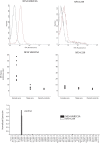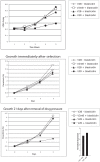An upstream open reading frame controls translation of var2csa, a gene implicated in placental malaria
- PMID: 19119419
- PMCID: PMC2603286
- DOI: 10.1371/journal.ppat.1000256
An upstream open reading frame controls translation of var2csa, a gene implicated in placental malaria
Abstract
Malaria, caused by the parasite Plasmodium falciparum, is responsible for substantial morbidity, mortality and economic losses in tropical regions of the world. Pregnant women are exceptionally vulnerable to severe consequences of the infection, due to the specific adhesion of parasite-infected erythrocytes in the placenta. This adhesion is mediated by a unique variant of PfEMP1, a parasite encoded, hyper-variable antigen placed on the surface of infected cells. This variant, called VAR2CSA, binds to chondroitin sulfate A on syncytiotrophoblasts in the intervillous space of placentas. VAR2CSA appears to only be expressed in the presence of a placenta, suggesting that its expression is actively repressed in men, children or non-pregnant women; however, the mechanism of repression is not understood. Using cultured parasite lines and reporter gene constructs, we show that the gene encoding VAR2CSA contains a small upstream open reading frame that acts to repress translation of the resulting mRNA, revealing a novel form of gene regulation in malaria parasites. The mechanism underlying this translational repression is reversible, allowing high levels of protein translation upon selection, thus potentially enabling parasites to upregulate expression of this variant antigen in the presence of the appropriate host tissue.
Conflict of interest statement
The authors have declared that no competing interests exist.
Figures





References
-
- Rogerson Sj, Mwapasa V, Meshnick Sr. Malaria In Pregnancy: Linking Immunity And Pathogenesis To Prevention. Am J Trop Med Hyg. 2007;77:14–22. - PubMed
-
- Fried M, Duffy Pe. Plasmodium Falciparum-Infected Erythrocytes Adhere To Chondroitin Sulfate A In The Human Placenta. Science. 1996;272:1502–1504. - PubMed
Publication types
MeSH terms
Substances
Grants and funding
LinkOut - more resources
Full Text Sources
Other Literature Sources
Medical

